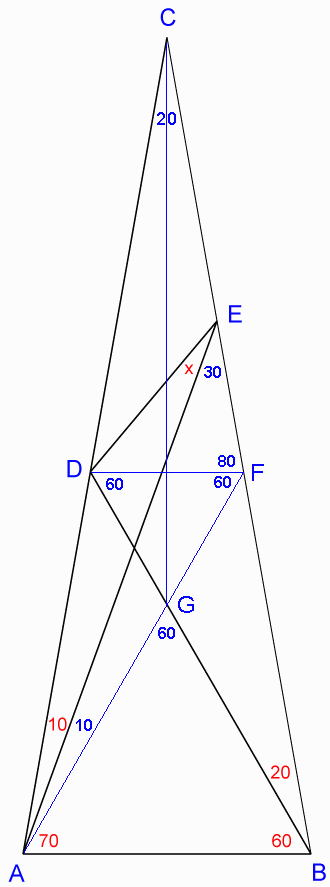Finding 'x' in a triangle
Community Forums/General Help/Finding 'x' in a triangle
| ||
I saw this in a cartoon show, it was a high school setting: Some character solves the problem and the answer is 'x = 20º'. I tried to find X too, but I couldn't. There seems to be some important information missing. Is it possible to solve that? PS: The image is a quick doodle in GIMP so the angles are not visually that accurate. |
| ||
| Use a protractor? :P From what I remember, all the internal angles of a triangle should add up to 180... so the very top angle is 20... the bottom inner triangle top angle is 50... |
| ||
| Yeah, the internal sum is 180, the external sum is 360. But when you find everything you can with these, you're left with 3 (or more) unknowns. The given answer works (20 degrees), but I don't know how to get to it. It's probably some property of triangles I don't know yet. |
| ||
| The problem as you present it there is underspecified from what I can see. x has an infinite number of possible values. The other angle in the upper left corner of that triangle with the 'x' in it if we call 'y' is another unknown. The complementary angles to that are constrained. All others are known. We are left with 2 unknowns and 1 equation - hence underspecified. So yes - 20 degrees is 'an answer' that works but so too does any other angle such as 40 degrees or an infinite number of others. |
| ||
| I remember seeing this years ago. It took forever to solve. First, some observations. Label the vertices at the left and right of the base as A and B, the label the top one C. There are two more points on the left and right sides. Call them D and F. Notice the base angles are both 80 degrees, 70+10 and 60+20. Thus edges AC and BC have equal length. Also notice the top angle is 20 = 180 - 80 - 80. Since angle DBE is also 20, the triangle BCD is isosceles, edges are equal. Draw a "helper" line through D, parallel to the base. Angle BDF must equal ABD ( both 60 ) since lines DF and AB are parallel and both are cut by DB. There is more to do on the way to a solution. It helps to draw a realistic sketch with the appropriate symmetry. Thanks to the wonders of the internet you can find many solutions. Here's the diagram:  That can be a little misleading. Keep in mind the original lines are black, original angles red. The solution is Problem 1 |
| ||
| Matty, Think about this intuitively, forgetting equations. Draw an arbitrary line segment AB as the base. Construct 80 degree angles at A and B. They intersect at a point C, the apex. C is precisely determined. Construct 60 degree angle at B, intersect with side AC to determine D. Likewise construct 70 degree angle at A and find E. So the entire ABCDE complex of the original diagram is exactly defined including angle AED, which is x. Of course the numerical value of x is non-obvious, but well defined. |
| ||
| I think you will find there are infinite solutions to the value of x. It is underspecified as i described. |
| ||
| Without specifying angle BDE there are infinite solutions. |
| ||
| Edit. I think i may have ignore a constraint. Give me a sec. |
| ||
| Thanks guys, I didn't know it's a notable problem. Perfect example of "thinking outside the box." At the end of all those statements you find that FD = FE (making triangle FDE isoceles), so: (X + 30) . 2 + 80 = 180 X + 30 = 100 / 2 x = 20 |
| ||
| Matty - there is NOT an infinite range of solutions. Simple maths gives the result 20 |
   |